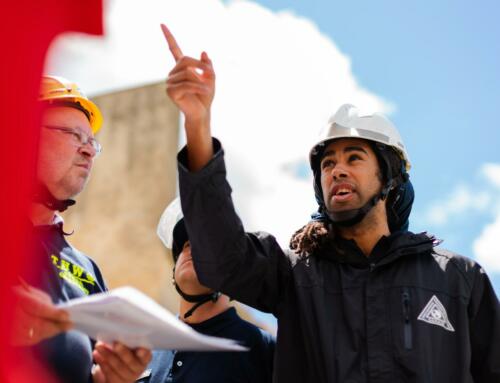![]()
No business would run without the human systems behind it. Companies need talented, competent people to survive. To run well and thrive, the company culture must embrace its people to better ensure harmony between them by managing how information is shared. Communication becomes paramount to progress.
An essential part of achieving that harmony is knowing one’s role within the workplace and executing it effectively. This applies at every level of the organization, but it is especially important that those at the top understand the importance of clearly defined company roles.
So what do we mean by “role?” Broadly speaking, there are three distinct contributor roles people fulfill within an organization:
- The Technician: Performs specialized and focused tasks as part of their work.
- The Manager: Supervises others, encourages and directs.
- The Leader: Oversees all functions and sets strategy for the enterprise.
As people move upward in their organization, they sometimes have trouble adapting to a new role. They lean on old behaviors instead of fully embracing their new responsibilities because it’s easier to use the skills they already possess. This prohibits real growth.
One of the most common instances of this occurs with new managers. We see the manager revert to their previous role of technician, trying to do everything themselves instead of delegating tasks. That, in turn, creates an unhealthy dynamic between the manager and their staff because the staff doesn’t feel heard or utilized to their full potential. This can end up driving away talented people that would otherwise fill the technician role.
While someone’s primary role changes with their position, it isn’t set in stone. Skills learned in previous roles can and should be utilized in new ones, just in different ways. A manager or leader can still be a technician if they’re performing specialized tasks related to their job. The challenge is figuring out the who, what, when, where and how of skill application to job function.
In this series of three posts, we’ll examine workplace roles from the perspective of three levels of company leadership: C-suite, Senior Management and Middle Management. We’ll look at what problems people face while working in their role, how this affects the unique goals of management at different levels of the business structure, and how best to solve those challenges when they arise.
We’ll begin by exploring how clear organizational structure and job-related roles can help executives at the C-suite level fulfill their goals.
Why Company Roles Matter for the Big Picture
As a C-suite executive, you are responsible for setting the company strategy, helping to establish culture, and guiding the company’s public reputation. Competitiveness, company economics, community impact and company legacy are just some of your many high-level daily concerns.
So how do organizational roles fit in? Defining and adhering to them can impact every area of business. People who know what their role is, what their duties are, and are encouraged to stick to those duties are likely to be happier in their work.
Part of the leader’s job is to establish a legacy — an enterprise strong enough to endure long after they’ve left. And you can’t do that without attracting and retaining top talent. Happier people are both better at their jobs and more likely to stay in them. Over time, this builds a more stable and sustainable business.
Naturally, holding on to talent impacts company finances. Lower job turnover means less time, money, and effort training people for new roles. People doing their job well means higher customer and client satisfaction, which often translates to more revenue.
When your people are performing well and client satisfaction is high, your company becomes highly competitive. It begins to do the work of attracting talented people through sheer reputation.
Take Google for example. Many people want to work there because it’s one of the wealthiest companies in the world, can provide top-notch benefits, and offers the chance to be on the cutting edge of the technology space. It’s had a consistent reputation for being among the best companies in tech, and that reputation attracts top talent.
A good reputation can also affect your standing in the local community. If an enterprise is competitive, has people that love their work, and regularly gives back, it will be perceived as a benefit to the community.
Being the head of a reputable company also boosts your reputation. There are many examples of corporate CEOs that become household names, but a business of any size can pair name recognition with a commitment to ethics and excellence. It is a perfect top-down goal.
That’s a tall order, so how do you make it happen? You start by clearly defining company roles.
How It Gets Done
First, effective communication is key. Company leadership needs to know in what direction they want to move, have a plan to achieve that goal, and motivate the people in their organization to achieve that vision.
An article by McKinsey and Company on 21st century leadership puts it this way:
“As visionaries, leaders shape the emergence of a clear, compelling purpose and vision – a North Star – that resonates throughout the organization and beyond. They don’t arrive at this in the boardroom. Rather…by observing and listening to people throughout the system… As visionaries, leaders also work with teams to translate the vision into measurable outcomes.”
Once people know their roles, they can focus on doing their work to the best of their ability. Knowing how their efforts fit into the bigger picture can also provide a sense of clarity and purpose. When leaders are straightforward about their expectations for the company and follow those expectations themselves, they set the proper tone and provide organizational stability and structure.
Today more than ever, people want to have a sense of purpose in their work. They want to feel like their jobs are providing something necessary not only to themselves, but to the world at large. Part of the leader’s job is to help their associates realize that purpose and strategically align duties and expectations to each person’s role.
Finally, it’s a leader’s job to provide support. If managers or staff are having difficulty, it’s the leader’s job to provide solutions to those issues. For example, if a policy isn’t working, they need to find out why, develop a solution, and communicate that solution to their management staff. If a mid-level manager is having trouble in their role, a leader can help by giving them guidance and resources to manage.
Defining roles and expectations balances these elements, creating a positive momentum within the organization and strengthening it from within.
The Value of Knowing Your Role
No matter what your role is, understanding it and acting on its specific responsibilities is key. For leaders, that means:
- Defining company roles
- Holding people accountable to fulfill their roles
- Providing support to help people be and do their best
- Establishing long-term goals and direction for the enterprise
Bellewether provides organizations with practice structures that include strategic role definition and organizational structures. Let’s engage to help make your business better.
This article is part of a series on the importance of defining organizational roles for the overall health and success of an enterprise. It focuses specifically on the C-suite Executives’ responsibilities and perspective on the matter. For information on additional job roles discussed in this series, click here: Senior Management | Middle Management






